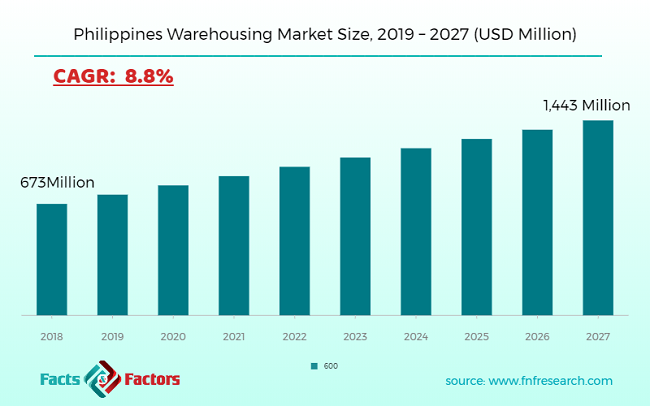Search Market Research Report
Philippines Warehousing Market Size, Share Global Analysis Report, 2019–2027

Philippines Warehousing Market By Type (General Warehousing, Agriculture, Cold Storage, Container Freight, and Others) and by End-User (Chemicals & Materials, Food & Beverages, Electronics, Pharmaceutical, Consumer Durables, and Others): Industry Perspective, Comprehensive Analysis, and Forecast 2019–2027
Industry Insights
[160+ Pages Report] According to the report published by Facts and Factors, the global philippines warehousing market size was valued around USD 673 million in 2018 and is expected to grow to around USD 1,443 million by 2027 with a compound annual growth rate (CAGR) of roughly 8.8% between 2019 and 2027. The report analyzes the global philippines warehousing market drivers, challenges, and the impact they have on the demands during the forecast period. In addition, the report explores emerging opportunities in the philippines warehousing market.

The report covers a forecast and an analysis of the Philippines warehousing market. The study provides historical data from 2013 to 2018 along with a forecast from 2019 to 2027 based on revenue (USD Million) and volume (Sq. Meter). The study includes drivers and restraints of the philippines warehousing market along with their impact on the demand over the forecast period. Additionally, the report includes the study of opportunities available in the Philippines warehousing market.
The major growth driver of the Philippines warehousing market is the growing adoption of technology, such as automated guided vehicles, voice-directed picking, and pick to light, particularly for large enterprises and their warehouses. In addition, the escalating trend of same-day delivery by e-commerce giants has revolutionized the entire concept of traditional to technologically-advanced and automated warehouses, which is likely to further boost the Philippines warehousing market in the years ahead.
In order to give the users of this report a comprehensive view of the Philippines warehousing market, we have included a competitive landscape and an analysis of Porter’s Five Forces model for the market. The study encompasses a market attractiveness analysis, wherein all the segments are benchmarked based on their market size, growth rate, and general attractiveness.
The report provides company market share analysis to give a broader overview of the key market players. In addition, the report also covers key strategic developments of the market including acquisitions & mergers, new launches, agreements, partnerships, collaborations & joint ventures, research & development, and regional expansion.
The type segment of the market is categorized into agriculture, cold storage, container freight, general warehousing, and others. By the end-user, the market is fragmented into consumer durables, food and beverages, electronics, chemicals and materials, pharmaceutical, and others.
 Report Scope
Report Scope
Report Attribute |
Details |
Market Size in 2018 |
USD 673 million |
Projected Market Size in 2027 |
USD 1,443 million |
CAGR Growth Rate |
8.8% |
Base Year |
2018 |
Forecast Years |
2019-2027 |
Key Market Players |
Acuity Management Solutions, Elevate, LexisNexis, BusyLamp, THOMSON Reuters, doeLEGAL, SimpleLegal, Onit, MITRATECH, and Wolters Kluwer ELM Solutions, among others. |
Key Segment |
By Product Type, by End-User, By Region |
Major Regions Covered |
North America, Europe, Asia Pacific, Latin America, and the Middle East & Africa |
Purchase Options |
Request customized purchase options to meet your research needs. Explore purchase options |
The study provides a decisive view of the Philippines warehousing market by segmenting it based on type, end-user, and region. All the segments have been analyzed based on present and future trends and the market is estimated from 2019 to 2027. The region segment includes the current and forecast demand for NCR, Bulacan, Cebu, Davao, Pampanga, Batangas, Cavite, Metro Iloilo, Bacolod, and Rest of Philippines.
 Some of the leading players in the global market include
Some of the leading players in the global market include
- Acuity Management Solutions,
- Elevate,
- LexisNexis,
- BusyLamp,
- THOMSON Reuters,
- doeLEGAL,
- SimpleLegal,
- Onit,
- MITRATECH,
- Wolters Kluwer ELM Solutions
This report segments the Philippines warehousing market as follows:
 By Type Analysis
By Type Analysis
- General Warehousing
- Container Freight
- Cold Storage
- Agriculture
- Others
 By End-User Analysis
By End-User Analysis
- Food and Beverages
- Chemicals and Materials
- Electronics
- Pharmaceutical
- Consumer Durables
- Others
 By Region Analysis
By Region Analysis
- NCR
- Bulacan
- Cebu
- Davao
- Pampanga
- Batangas
- Cavite
- Metro Iloilo
- Bacolod
- Rest of Philippines
Industry Major Market Players
- Acuity Management Solutions,
- Elevate,
- LexisNexis,
- BusyLamp,
- THOMSON Reuters,
- doeLEGAL,
- SimpleLegal,
- Onit,
- MITRATECH,
- Wolters Kluwer ELM Solutions
Frequently Asked Questions

Copyright © 2024 - 2025, All Rights Reserved, Facts and Factors


